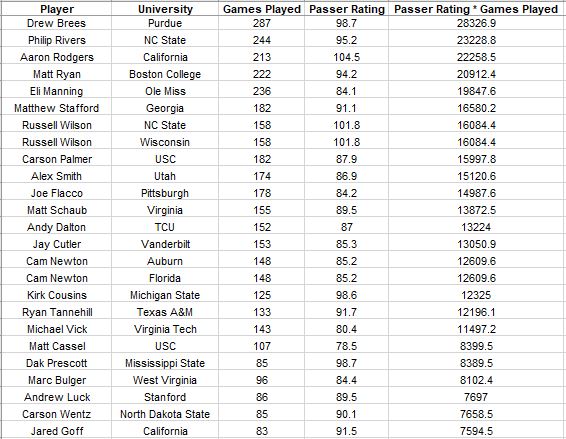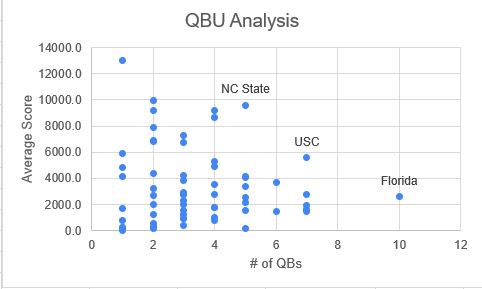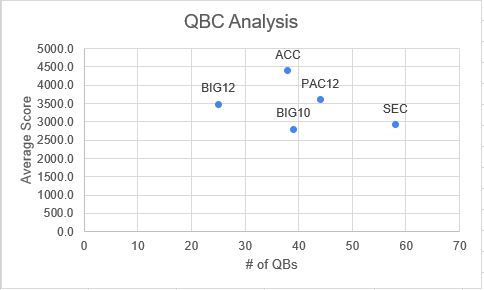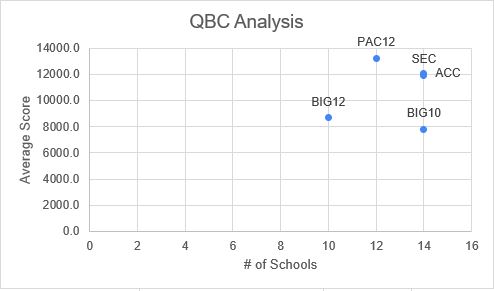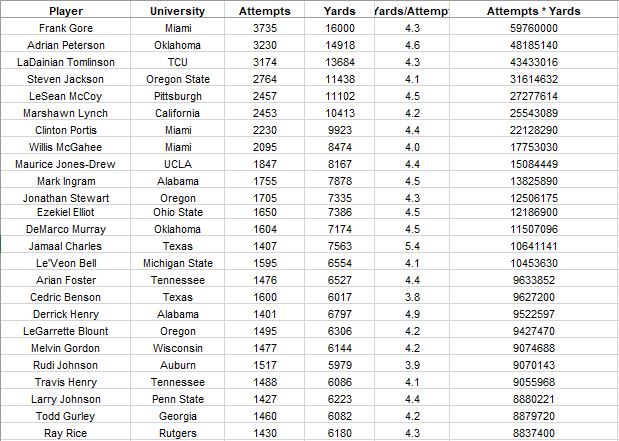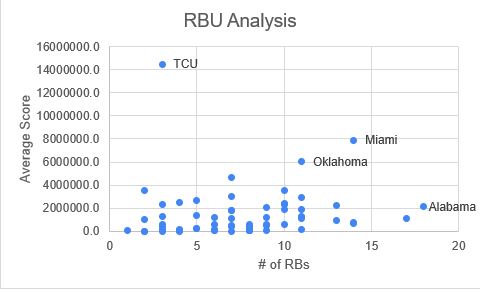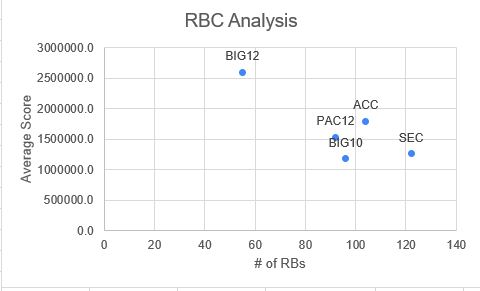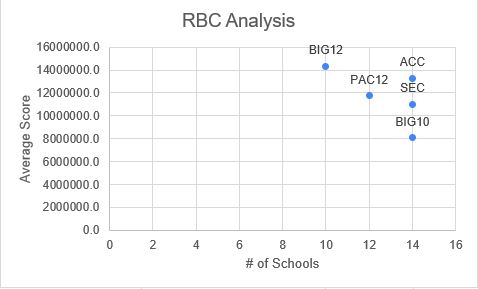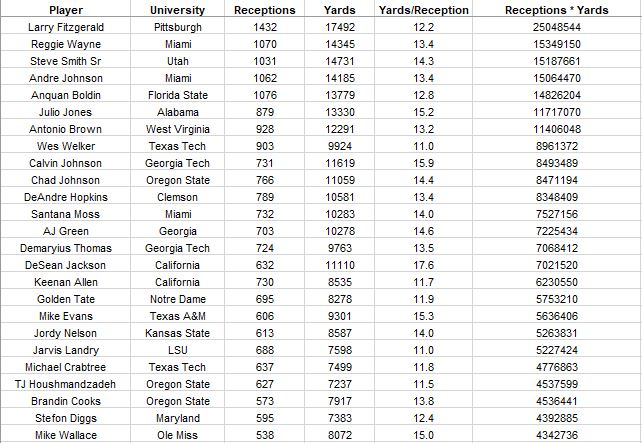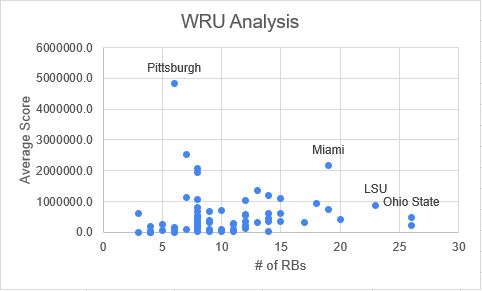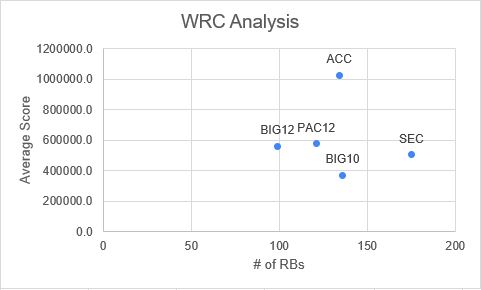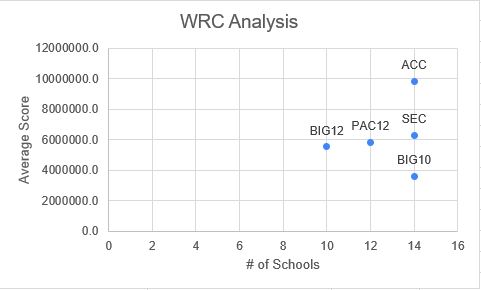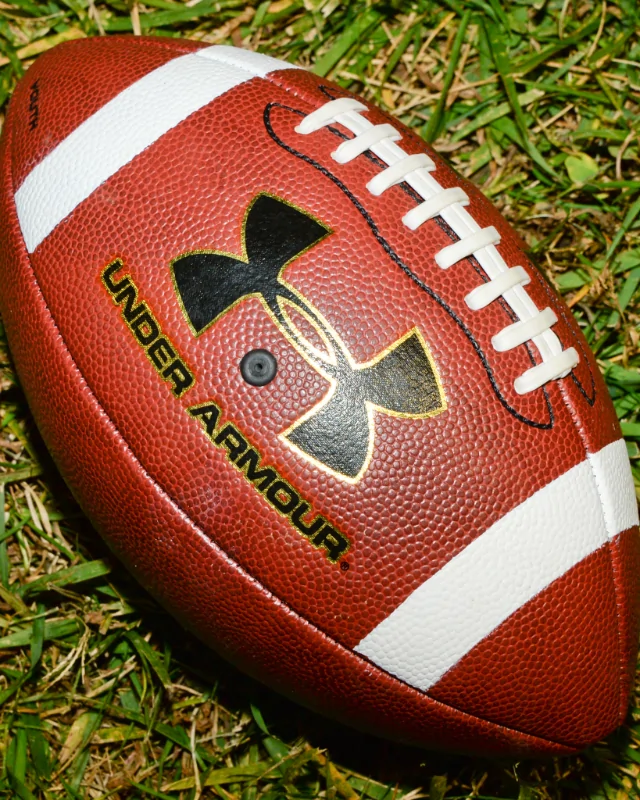
Since 2000, every college football program has had its ups and downs. But which universities are producing the most successful professional athletes? By looking at two key statistics from each position, we can determine not only the best universities for NFL success, but the best conferences as well.
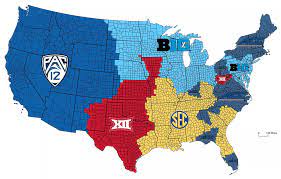
Key Statistics
Recorded statistics have become more and more complex in the NFL throughout the past twenty-plus years. There are numerous statistics that the majority of people do not understand, but for this research, simple statistics were used. For quarterbacks, games played and passer rating were used. Passer rating is a common statistical measure that grades quarterbacks on a scale of 0 to 158.3 using a formula, but it encapsulates other statistics like completion percentage, yards, touchdowns, and interceptions. For running backs, rushing attempts and yards were recorded, while for wide receivers, it was receptions and yards. Rushing attempts and receptions were used instead of games played because they are a better indicator of skill for those positions.
Data Explanation
This data was collected from Pro-Football-Reference, an online database that contains data from current and historical NFL seasons. It is important to note that the statistics were recorded from 2000 through the 2021 NFL season. Players were eligible to be in the dataset by playing a snap in both college and the NFL during or after the year 2000. For example, Tom Brady is ineligible because he played his last college snap in the 1999 college football season, but Drew Brees was included because he took his last college snap in the 2000 college football season. To give each player a “score”, his two key statistics were multiplied together. This occurs because longevity is a better indicator of professional success than short-term above-average play. These scores determine the “best” players in this scenario, but the best universities and conferences can also be determined by grouping players together based on their universities and conferences. Some players occur twice because they went to multiple universities, and each of these universities deserves credit for their player’s success when evaluating the top universities and conferences.
Top Quarterbacks
Quarterback is arguably the most important position on the football field. They touch the ball on almost every offensive play and are often viewed as the leader of the team. A quarterback has been selected first overall in the NFL draft more than any other position, which shows how important a quality quarterback is. Since 2000, there have been 198 quarterbacks that have taken a college and NFL snap. The best players according to their defined score were Drew Brees, Philip Rivers, and Aaron Rodgers. There were lots of quarterbacks who received a score of 0 due to a career 0 NFL passer rating. Some notable names are Feleipe Franks, Sam Ehlinger, and Kurt Benkert. There are lots of great quarterbacks who are not near the top of the list purely because of the small number of games they have played. Current NFL stars like Patrick Mahomes, Deshaun Watson, and Joe Burrow are near the top in terms of career passer rating, but they have not played nearly as many games as players like Brees and Rivers to be considered the best. Below is the list of the top 25 quarterbacks according to the model.
Top Quarterback Universities and Conferences
To evaluate which universities are truly the best at producing NFL quarterbacks, the number of quarterbacks they have produced and the total score of those quarterbacks were collected for each university. Each school was graded by averaging the total score by their number of quarterbacks. So, if a school produced 5 quarterbacks and their total score was 2000, the school would receive a score of 400. The University of Florida produced the most quarterbacks with ten, while five programs tied for second with seven. They are USC, Texas A&M, Stanford, LSU, and Ohio State. Plotting the number of quarterbacks by the average score showed which universities are in the running for being labeled “Quarterback University (QBU)”.
While Vanderbilt technically had the highest average score, that was because they only have had one NFL quarterback since 2000. That player is Jay Cutler, who had a long NFL career, but they cannot be deemed QBU based off of one player alone. Quality and quantity were both important, and Vanderbilt lacks the quantity. The University of Alabama and Oklahoma University have produced lots of quality NFL quarterbacks recently, but these players are so young, which means they do not have enough games played to get their scores near the top. According to this data, NC State is deemed QBU. They have the third-highest average score while still producing five NFL quarterbacks. There were only 8 universities that produced more NFL quarterbacks than the Wolfpack, but NC State has both quality and quantity on its side. Their five quarterbacks are Philip Rivers, Russell Wilson, Jacoby Brissett, Mike Glennon, and Ryan Finley.
For conferences, only the Power Five conferences were investigated further. No other conference has nearly enough NFL quarterbacks to compete with these five. Scores were calculated for conferences just like they were for universities, and the results are quite interesting.
The Southeastern Conference has produced the most quarterbacks since 2000, and they also have the most quarterbacks per university. If the goal is quantity, then the SEC is the best conference. That being said, it is the ACC that is producing the highest quality quarterbacks by score, on average. With players like Philip Rivers, Matt Ryan, Russell Wilson, and Deshaun Watson, the ACC is crowned as the QBC.
Top Running Backs
Running backs have the shortest shelf-life out of any position in the NFL. It is the least durable position of them all due to the workload that these players experience throughout their careers. The league average for length of a career is about 3.3 years, while running backs only make it for about 2.57 years. Because of this fact, running backs with lots of carries are rare, and thus very valuable. Since 2000, there have been 473 running backs that have taken a snap in both college and the NFL. The best running backs according to the collected data are all legends. They are Frank Gore, Adrian Peterson, and LaDainian Tomlinson. Listed below are the top 25 running backs since 2000.
Top Running Back Universities and Conferences
Identifying the top universities and conferences was done in the same way that quarterbacks were. The University of Alabama has produced the most running backs since 2000 with 18, which is followed closely behind by LSU with 17. Miami, Notre Dame, and USC round out the top five with 14 running backs each. The University of Kansas ranks dead last with only one NFL running back since 2000, and that player is Khalil Herbert. Below is the plot analysis for RBU.
TCU runs into the same problem with running backs that Vanderbilt did with quarterbacks. They have only produced three NFL running backs, and their score is propelled by the success of LaDainian Tomlinson. The other two TCU running backs are George Layne and Aaron Brown, who combined for 48 total rushing attempts in the NFL. The battle for RBU comes down to the University of Miami and the University of Alabama. Miami has produced players such as Frank Gore, Clinton Portis, Willis McGahee, and Lamar Miller, while Alabama has produced players such as Mark Ingram, Derrick Henry, Alvin Kamara, Josh Jacobs, and Najee Harris. The title of RBU has to go to the University of Alabama because of the number of successful running backs they have produced. Both of these schools have produced seven running backs who have less than 100 rushing attempts, but Alabama has four more backs who have 100+ rushing attempts. The Crimson Tide gets the nod here.
With the success of running backs from the University of Alabama, the SEC is going to be very difficult to overcome in terms of the best running back conference. Below are the results for the Power Five conferences.
Even though Alabama was crowned as RBU, the SEC does not give its juggernaut the support it needs to be the best RBC. Instead, the honor of being the best conference for a position once again goes to the ACC. They have a total score higher than the SEC with 18 fewer running backs. Because of this, their average scores per player and per school are significantly higher than any conference that is not the BIG12. An argument can be made for the BIG12, but the ACC is six running backs away from doubling their running back count. They simply have not produced enough NFL talent at the position to take home the award. The ACC has produced NFL stars like Frank Gore and Clinton Portis from Miami, LeSean McCoy from Pittsburgh, and Dalvin Cook from Florida State. For now, the ACC gets the throne of RBC, but this could change soon. The SEC has lots of young running backs that are still getting better, and the BIG12 has the quality, but not the quantity, to claim the throne. In a couple of years, it could be anybody’s race.
Top Wide Receivers
Wide receivers were the final position investigated in this study. This position is quite interesting because of how long a player can find success in the NFL. Even when a player is well into his 30s, he can still play at a high level and continue to collect stats. There have been 672 wide receivers to take a college and NFL snap since 2000, and the top five are as follows: Larry Fitzgerald, Reggie Wayne, Steve Smith Sr., Andre Johnson, and Anquan Boldin. The top 25 wide receivers are listed below.
Top Wide Receiver Universities and Conferences
Four schools have produced 20+ wide receivers in the NFL since 2000. They are Ohio State University, the University of Florida, LSU, and USC. Two schools were tied for last in terms of producing wide receivers, and they are Duke University and Purdue University. These Duke receivers have a combined 410 catches, with 409 of them coming from Jamison Crowder. The most notable Purdue receiver is Rondale Moore, which goes to show how Purdue has not been able to produce NFL wide receivers.
For the third time in as many positions, we have a university that far exceeds the rest due to the small number of players they have produced. This time, the University of Pittsburgh’s average wide receiver is much better than any other school’s, but they have only produced six wide receivers in the time frame. The Panthers are led by Larry Fitzgerald, who is accompanied by Antonio Bryant and Tyler Boyd. Pittsburgh also has a receiver that never caught an NFL pass, or else their average would be even higher. The University of Miami is led by three main receivers: Andre Johnson, Reggie Wayne, and Santana Moss. While all of these receivers are very good, they do not have the supporting cast to claim the top spot. The difference between LSU and Ohio State is very small, but the edge goes to LSU. With receivers like Jarvis Landry, Dwayne Bowe, Odell Beckham Jr., and Brandon LaFell, who are accompanied by two of the league's brightest young receivers in Justin Jefferson and Ja’Marr Chase, it's hard to argue that they do not deserve it.
With the successful programs that LSU and Ohio State have, it is hard to imagine that either the SEC or BIG10 will not claim the title of WRC. Well, the results might be shocking.
From the tables and charts, it’s clear that the ACC is WRC. They have a total score that is almost equal to the sum of any two other conferences, and their average score per player is almost twice as large as any other conference’s. They have the third most receivers produced, but they are only two receivers behind the BIG10. The only knock against the ACC is their receivers per school, but they are so close to the BIG10, BIG12, and PAC12 that it’s almost negligible. The ACC is responsible for four of the top five receivers overall, Georgia Tech’s Calvin Johnson, and Clemson’s DeAndre Hopkins, to name a few. The conference got major contributions from five of their fourteen schools, and they have the supporting cast to crown the ACC as WRC.
Conclusion
We had three positions, and the ACC claimed the throne for all three of them. Some might want to call author bias, but the numbers speak for themselves. What could have been done differently? The ACC had the right mix of quantity and quality for each position. An ACC school was selected only once as the top university for a position, and it was not their superior programs like Clemson, Florida State, or Miami. NC State University helped the ACC with quarterbacks, but the SEC had the top dog for the other two positions. They simply did not get the help from their SEC counterparts that they needed to be able to claim the title of the top conference. If you’re looking for quantity, then the SEC is your conference, but in terms of quality NFL products in the 21st century, the Atlantic Coast Conference is truly the best.
Sources
Armetta, Bryan. “Who Put All the ‘Power’ in College Football's Power 5?” GMTM, 4 Jan. 2021, https://gmtm.com/articles/why-does-the-power-5-have-so-much-power.
Sports Reference LLC. Pro-Football-Reference.com - Pro Football Statistics and History. https://www.pro-football-reference.com/.
Biography
Keegan Sullivan is a senior at Clemson University. He is a mathematical science major with an emphasis in statistics and is getting a minor in sports communication. He is currently an intern with Clemson’s Olympic Sports Science Program, and his goal is to be a data analyst for a professional sports team once he gets his degree. Here is a link to his LinkedIn profile.

